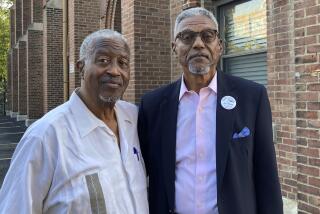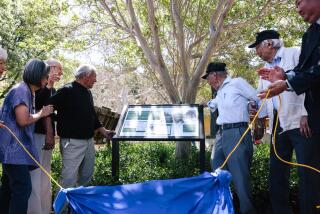Memos Say U.S. Hid Japanese War Crime
‘If you survived one experiment, they used you again; no one escaped death.’
Sheldon Harris, CSUN professor
What took place at the Japanese prisoner-of-war camp known as Unit 731 was unspeakable. More than 3,000 Chinese and Russian prisoners died at the camp in occupied China, the victims of germ warfare experiments by the Japanese during World War II.
But what happened after the Allied victory in 1945 is just as chilling, said Cal State Northridge history professor Sheldon Harris: The United States secretly protected the Japanese army doctors of Unit 731 from prosecution as war criminals. In return, the Japanese officers gave U.S. military authorities the data from their grisly human experiments.
Harris said he has proof of the deal in formerly top secret documents he obtained through the federal Freedom of Information Act. In response to Harris’ research and inquiries, the U.S. Army, after years of denying the story, has confirmed the basic facts of the deal.
“The fact is, we made a joint decision not to prosecute,” said Norman M. Covert, an Army spokesman at Fort Detrick, Md., where the military conducts its biological warfare research. “. . . The driving point was to retain the information within friendly channels. That’s why we did it, to keep the information out of the hands of the Soviets.”
Harris, a teacher of American and film history who became fascinated with the subject during a tour of China in 1985, is preparing the first scholarly study of the episode. He plans to write a book about it, probably next year.
Denials Issued
The Army had denied that the government protected the Japanese army doctors who ran Unit 731, beginning when the first English-language article on the subject was published in 1981, and as recently as August, following a science conference at UC San Diego.
“The whole cover-up is remarkable,” said Harris, who has visited the former germ warfare factory near Harbin, China, during his research.
Even now, Covert, a military historian who has done most of the Army’s research of the incident, said, “The U.S. government and I will never say that a deal was made . . . but it can be interpreted that way.”
That’s probably as close to an admission as will be made by the Army, said John Dower, a professor of Japanese history at UC San Diego and an acknowledged expert in the field. “Even if you drop a ton of evidence, the government is slow to concede these things,” he said.
Dower credits San Francisco writer John W. Powell with doing most of the groundwork on the experiments, which were first reported in Powell’s article for the Bulletin of Atomic Scientists in October, 1981.
Powell said in a telephone interview that he is pleased to see historians such as Harris pursue the story and prod the Army to release more information. “It’s a step forward to setting the record straight,” he said.
Dower said the historical conclusion that can be drawn from Harris’ and Powell’s research is that the United States “was simultaneously involved in exposing some Japanese war crimes and covering up others.”
“After the war, as in the case of the Nazis, we were engaged in enlisting fascists and murderers to our side who we felt had skills or knowledge that would be useful in the Cold War,” Dower said. “While it is a natural development, it’s not a very attractive one because, particularly in the case of biological warfare, we are talking about the commission of the grossest, most horrendous sorts of atrocities.”
While Nazi doctors were put on trial for war crimes by the International War Tribunal at Nuremberg, Harris said that formerly top secret documents show that U.S. military authorities agreed to keep secret the evidence collected against the Japanese who ran Unit 731.
U.S. authorities at the time believed the data from human experimentation performed by the Japanese would advance the country’s knowledge of biological warfare, Harris said.
TV Documentary
The first reports of biological warfare experiments conducted at Unit 731--which has been converted by the Chinese into a memorial--surfaced more than 10 years ago in a Japanese television documentary. Since then, historians have determined that Japanese doctors and scientists killed thousands of Chinese and Russian prisoners, as well as nearby villagers, by infecting them with diseases such as plague, cholera, anthrax, typhoid and syphilis.
Other prisoners were exposed to chemical weapons such as mustard gas. Some were exposed to radiation, others injected with horse blood and many dissected while alive, Harris said.
“If you survived one experiment, they used you again; no one escaped death,” Harris said.
He said the Japanese then field- tested their findings; for example, by dropping loads of plague-infested fleas on Chinese troops and villagers.
But Harris said his research shows that the United States, eager to advance its own biological warfare capabilities, kept secret the allegations made shortly after the end of the war that prisoners of war, possibly some Americans, were used in tests of germ bombs and vaccines at the Japanese death camps. Those allegations, some made by Japanese Communist Party officials, were dismissed by U.S. authorities in an August, 1947, memo as “hearsay . . . and rumors.”
Valuable Data
But Harris said that documents from the time make it clear the United States feared that bringing charges against Japanese officers who directed the death camps would disrupt negotiations for valued biological warfare information.
“This Japanese information is the only known source of data from scientifically controlled experiments showing the direct effect of BW (biological warfare) on man,” said an Aug. 1, 1947, memo from the State War Navy Coordinating Committee, a top-level government bureaucracy formed after World War II. “In the past it has been necessary to evaluate the effects of BW agents on man from data obtained through animal experimentation. Such evaluation is inconclusive and far less complete than results obtained from certain types of human experimentation.”
Memos show that the coordinating committee members determined that by keeping the information gained about Unit 731 top secret, they could guarantee that Lt. Gen. Shiro Ishii, head of the camp, and his men would be protected from the International War Tribunal being conducted in Tokyo.
Memo to MacArthur
“For all practical purposes, an agreement with Ishii and his associates that information given by them on the Japanese BW program will be retained in intelligence channels is equivalent to an agreement that this government will not prosecute any of those involved in BW activities in which war crimes were committed,” reads a 1947 memorandum to Gen. Douglas MacArthur from the coordinating committee. “Such an understanding would be of great value to the security of the American people because of the information which Ishii and his associates have already furnished and will continue to furnish.”
The coordinating committee feared that putting Ishii and his men on trial would reveal the results of their biological warfare experiments to the Soviets and other competing nations, according to memos collected by Harris.
“Since it is believed that the U.S.S.R. possesses only a small portion of this technical information, and since any ‘war crimes’ trial would completely reveal such data to all nations, it is felt that such publicity must be avoided in interests of defense and security of the U.S.,” the memo said. “It is believed also that ‘war crimes’ prosecution of Ishii and his associates would serve to stop the flow of much additional information of a technical and scientific nature.”
Allied nations at the time were putting Nazi officers and doctors on trial in Nuremberg for similar atrocities. Minutes from a Sept. 26, 1947, meeting of the coordinating committee obtained by Harris show that one unnamed official, aware of the potential conflict, conceded that if word of the negotiations became public, “this government may at a later date be seriously embarrassed.”
Evidence Lacking
Despite the documents, Army historian Edward J. Drea of the Army Center of Military History in Washington said last week that U.S. authorities didn’t prosecute Ishii because there was not enough evidence.
“It came down to the problem that prosecutors didn’t have enough evidence for an indictment,” Drea said.
But Ishii and his men did provide the United States with lengthy scientific reports covering their 9 years of biological experiments on prisoners. The men also provided reports on their testing of biological weapons on crops and animals, as well as photographs of 8,000 blood and tissue slides taken from autopsies of humans and animals subjected to biological warfare experiments, according to declassified Army documents obtained by Harris.
An Army spokesman said those materials were sent back to Japan in the early 1950s.
Harris, who has received university funding to pursue his research, said he stumbled onto the story. In 1985 he was visiting China in a university exchange program sponsored by CSUN.
At the end of the tour, Harris said, “I was ready to give my lecture, have the banquet and get on the next plane home.” But local officials took him to the site of the former death camp.
Harris interviewed residents there who remembered the death camp and outbreaks of diseases such as the plague that hit local villages during the war.
Harris said that on and off for the next 2 years, he researched Unit 731. He presented a paper on the subject to a conference of scientists in Cologne, West Germany, in September.
More to Read
Sign up for Essential California
The most important California stories and recommendations in your inbox every morning.
You may occasionally receive promotional content from the Los Angeles Times.










